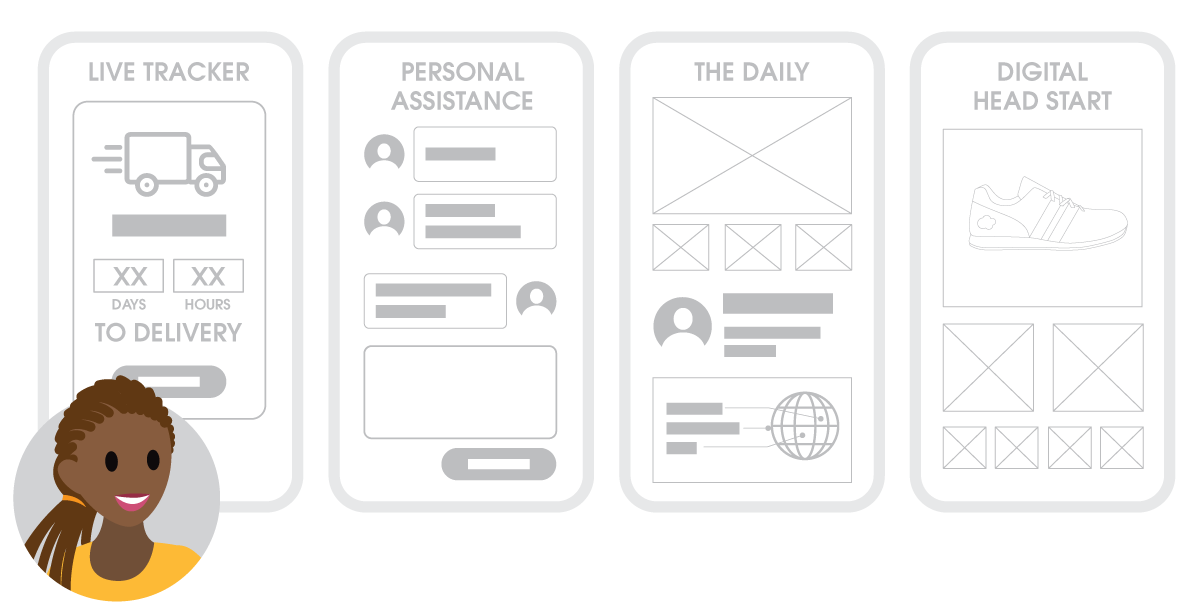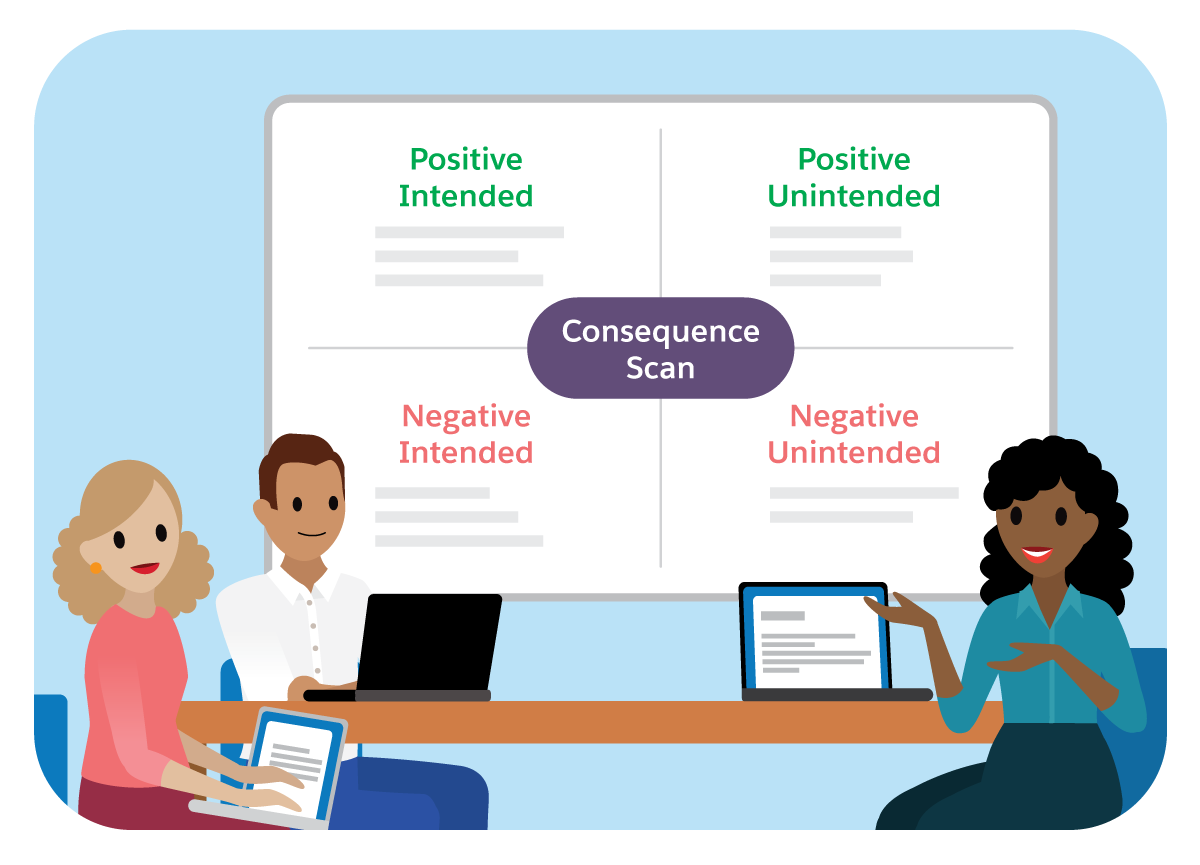Analyze and Narrow Solution Concepts
Learning Objectives
After completing this unit, you’ll be able to:
- Explain key considerations for narrowing solution concepts.
- Explain the role of Consequence Scanning in narrowing concepts.
Once you identify the core concepts you want to develop, the process you go through is a cyclical iteration of visualizing, analyzing, and critiquing your concepts to strengthen and refine them. As you develop them, remember to refer back to your project goals to make sure you’re driving toward them.
Analyze each solution concept based on:
-
Desirability: Think of this as what’s valuable to the user. Return to the research insights gathered earlier to ensure the solution concept aligns with user needs. You can also share early concepts with customers for feedback.
-
Viability: Think of this as what’s valuable to the business. Look at how the solution concept and related Jobs to Be Done (JTBD) helps your organization reach ideal business outcomes. Also, consult with business analysts to examine ways to strengthen concepts’ viability.
-
Feasibility: Think of this as what’s technically possible. Share concept ideas with developers or architects to determine technical feasibility and learn about any concerns.

Create a comparison chart to support your analysis and better understand the merits and tradeoffs of each concept. For example, how does each one drive the high-level business outcomes connected to the design project? What kinds of investment does each require? How does each concept serve user needs, and how do you measure success? What impact does each concept have on values-based, social, and environmental goals? Do any of them feel unique enough to create an enduring advantage in the market?
As you analyze each concept from these different perspectives, you inevitably uncover weaknesses and strengths and refine concepts based on your understanding of what is ideal in terms of desirability, viability, and feasibility. You also start to visualize what they look and feel like, and think through how you might approach building them. The more times you iterate on your concepts, and the more times you tell people about them—in casual conversation, not presentations—the tighter your elevator pitch about them becomes. You also get more feedback on what excites people and gives them pause.
To work through the questions that arise from your analysis, you should create wireframes or even high-fidelity mockups of key moments in each concept.

This helps answer questions like whether it's the right solution to your customer’s challenges, and test how it looks, feels, and behaves. You might even build prototypes to answer specific questions or explore how concepts could come to life. This is covered in the Strategy Design Prototyping module.
Bring in thought partners (individuals who challenge your thinking or assumptions and inspire innovation) to help you shape the concepts during this analysis stage—this is the moment for judgment and constructive skepticism. Your goal is to develop a few unique concepts—three is usually a good number to shoot for—to the point where you feel each is ready to present them to decision-makers and stakeholders.
Continue to cycle through these activities: visualize, analyze, and critique your concepts until you either build confidence in your concepts or decide to eliminate them. You may eliminate a concept because you can’t get it to work, because you have other, stronger ones, or because you realize you can combine the best parts of two or more concepts to arrive at a different, better one.
Eliminating your concepts—also known as killing your darlings, with a hat tip to the literary world—takes maturity and courage, especially once you’ve invested time in developing them. Ultimately, you can feel good about having done the best thing for your team, project, and organization every time you eliminate one for good reasons. You free up your team to invest their energy into more promising concepts, improve your project’s chances of success, and save your organization from building the wrong thing. It’s a worthy sacrifice.
In addition to the analysis and prioritization factors above, you can use Consequence Scanning to interrogate high-level solution concepts.
Consequence Scanning
Before presenting concepts to decision-makers, it's best practice to examine their potential impact on communities and greater society through Consequence Scanning. Consequence Scanning is a process teams use to interrogate solution concepts to consider their potential effects by asking three key questions.
- What are the intended and unintended consequences of this product or service feature?
- Within these intended and unintended consequences, which are positive?
- Within these intended and unintended consequences, which are negative?
Consequence Scanning involves facilitating a workshop designed to answer those questions, with a group of people brought together for their diversity of perspectives. Let’s check in with Cloud Kicks to learn more about the Consequence Scanning process.
Cloud Kicks’s Consequence Scan
Through brainstorming, concepting, and co-creation sessions, followed by analysis and a bit of customer research, the Cloud Kicks team has narrowed down to its three top solution concepts:
- The Live Tracker with real-time updates on order delivery
- The Daily email status update sent with inspiration
- A Signature Tag to spotlight where sustainable materials came from

By facilitating a brainstorm on consequences and plotting them on a 2x2 grid, Cloud Kicks gains a better understanding of important considerations, including whether their concepts:
- Create unequal outcomes for any customers, such as whether their Signature Tag concept might be inaccessible to certain groups or individuals.
- Harm or enhance customer trust, such as whether they might be risking their employees’ privacy rights by sending photos in the Live Tracker experience.
- Assume any unnecessary risks to community or society through its operations, such as using excessive amounts of energy to get, store, and send real-time data all across their supply chain.
Beyond discovering potential risks, the Consequence Scan prompts the team to decide which issues to act on immediately, which ones to influence, and which ones to monitor.
Taking the time to examine the impact of a product or service and ensure ethical considerations are built-in is a vital part of the design process. When teams don't consider these important questions and factors until the end of the design process, they risk putting time and resources into building products and services that could cause serious harm to communities, society, and their business. And on top of this, they risk losing trust with their customers.
Next, you learn how to frame a solution concept as a cohesive vision for a product or service.
Resources
-
External Website: IDEO U: Collaboration Resources
-
Trailhead: Accountability in Design
-
Trailhead: Ethics by Design
-
External Site: How to Run a Consequence Scanning Workshop
